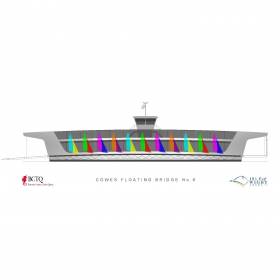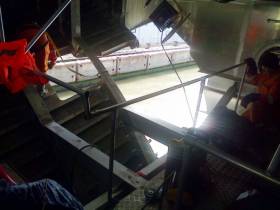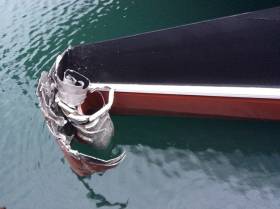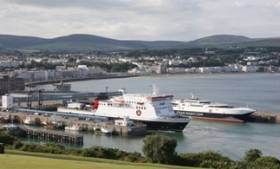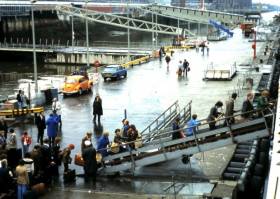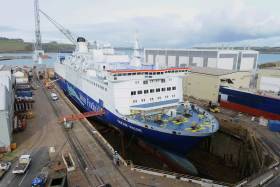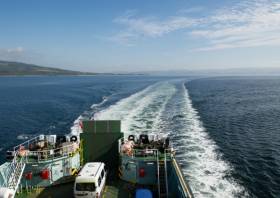Displaying items by tag: Ferry news
Sailing Mecca of Cowes To Get New ‘Floating Bridge’
#FloatingBridge – A replacement for the Isle of Wight’s Cowes-East Cowes Chain ferry known affectionately as the ‘floating bridge’ is to be introduced next year at the famous sailing venue, writes Jehan Ashmore.
The busy crossing on the River Media, is one of the few remaining in the UK that has not been replaced by a physical bridge and the 37m newbuild to be built in Wales. The newbuild will form the sixth generation ‘floating bridge’ since the service began in 1859.
The contract for the chain-ferry has been awarded to Pembrokeshire based boat-builder, Mainstay Marine Solutions Ltd. The order at the Pembroke Dock yard will create another 20 jobs bringing the workforce up to 100.
The newbuild to a design by Burness Corlett Three Quays (BCTQ), incorporates an upper and lower deck for passengers to access during the crossing and features panoramic windows to optimise light and viewing of the scenic river and harbour setting.
Currently, the 18 hours a day operation which only takes 2.5 minutes to complete is operated by No. 5 Cowes Floating Bridge, which has been in service for the last four decades. The frequency of every 10–15 minutes allows to transports around 1.5 million pedestrians and 400,000 vehicles annually.
The newbuild will have even greater generating capacity given additional space for foot passenger and vehicles to board at the same time and help reduce on loading times.
The Cowes service has been owned and operated by the Island’s local authority since 1901 and more than a hundred years later this latest floating bridge is to be funded by the Isle of Wight Council and the Solent Local Enterprise Partnership as part of the East Cowes Regeneration Project.
The drive through, roll-on roll-off chain ferry with hydraulically operated loading and unloading ramps at each end of the vessel. The deck will have 4 lanes for vehicles with additional space for the stowage of motorbikes, scooters and bicycles.
Designed in accordance with the BV’s classification of Inland Navigation Vessels, the 37m long vessel will be capable of reaching up to 5 knots and will carry a total deadweight of no less than 52.65 tonnes.
The project is due for completion at the end of the year with trails and commissioning at Cowes in January 2017.
#FerryOrProperty? – April used to mark the opening of seasonal-only Dun Laoghaire-Holyhead ferry services until Stena Line withdrew operations in 2014, since then there has been no sign of a new operator to resume the service to Wales, writes Jehan Ashmore.
In response to queries from Afloat, Dun Laoghaire Harbour Company this week said they were not in a position to comment any further on the matter of a new ferry operation. The comment echoes a statement by DLHC as previously reported on Afloat earlier this year.
Notably, Dun Laoghaire Harbour’s St. Michael's Pier passenger terminal from where the HSS fastferry craft used to berth alongside is currently to let. The property agent describes the extensive two-storey building as the ‘former’ ferry terminal, where the arrival /departure hall is to let with a retail property area of (4,207.00 sqm).
The terminal complex has a further two properties to let, an office property (4,736.00 sqft) from where Stena are understood to have previously partly occupied.
Also on this second floor is a former restaurant (the Purple Ocean) with a retail property (2,325.00 sqm) which too is available to let.
To reflect on Stena’s decision to pull out of Dun Laoghaire, there were several reasons. Chiefly a continuous declining market on Dun Laoghaire-Holyhead route coupled by high fuel costs of the fuel thristly fast-craft HSS Stena Explorer, competition on the Dublin route and air travel.
In order to stave off costs on the loss making route, Stena in 2012 abandoned the year-round service to a seasonal-only April to September schedule. In addition frequency was reduced to just a single daily round trip coupled by an increase in passage times. Again this measure was to minimise on the expensive to run HighSpeed Sea Service (HSS) craft.
It was not until early 2015 that Stena finally officially confirmed it was permanently pulling out of Dun Laoghaire Harbour. At that stage the HSS fastcraft had already been laid-up in Holyhead since September of the previous year.
The ferry firm instead consolidated existing Dublin Port-Holyhead operations and by introducing a second route ferry, Stena Superfast X that displaced a smaller ro-pax.
Effectively, the much larger ‘Superfast’ replaced the HSS albeit running out of the Irish capital.
Damaged Fastferry Remains Out of Action Until Sunday
#RepairDelays - The damaged Isle of Man Steam Packet fastferry Manannan has not returned to service as planned this morning - and will remain out of action until Sunday at the earliest.
According to IOM Today, the fastferry is to remain in dry dock at Cammel Laird’s shipyard in Birkenhead undergoing repairs after crashing into Victoria Pier in Douglas a week ago.
A statement from the company isued this morning said: ‘The Steam Packet Company regrets that Manannan will not be able to return to service today as planned.
‘Unfortunately we have been unable to finish the work within the compressed timetable after getting into dock 24 hours later than expected due to the previous ship in there over-running.
‘Due to low tide heights over the next few days the first available un-docking tide is 7am on Sunday, April 3.
‘The Steam Packet Company would like to apologise for the ongoing inconvenience to passengers , we are working on alternative sailing arrangements and will issue an update later this morning. We would ask that passengers do not call until the alternative arrangements are announced later.’
For the latest information on ferry sailings and services, visit the operators website here.
#DelayedRepairs - A dry docking of Manannan in Liverpool has been delayed and means the fastferry will now return to service on Thursday morning, as long as repairs go as planned.
The vessel reports IOM Today was damaged when it collided with the Victoria Pier in Douglas at around 10pm on last Wednesday night.
Five passengers suffered injuries and were taken to hospital for further treatment.
The incident is still being investigated but early indications suggest it may have been a systems control failure.
It caused travel disruption over the busy Easter period with all sailings to Ireland (Dublin) cancelled and passengers booked on the Liverpool route transferred on to the Ben-my-Chree’s Heysham services.
Manannan sailed to Birkenhead for repairs at Cammell Laird (yesterday) and it was hoped she would return to service on Wednesday.
Fastferry Crash Due to ‘Systems Failure’ says Steam Packet Boss
#SystemsFailure - Fast-ferry Manannan that crashed in to Douglas’s Victoria Pier on Wednesday was due to ‘systems failure’, according to Steam Packet chief executive Mark Woodward.
The IOM Today yesterday reported that five people were taken to hospital after the vessel collided with the harbour wall at around 10pm.
A statement issued by the company this morning revealed the passengers were initially treated on board Manannan before being taken to hospital by ambulance for further assistance.
It’s since been confirmed that none are seriously injured.
Mr Woodward said: ‘Safety is absolutely paramount to the Steam Packet Company and we have launched a detailed investigation to find out what has caused the incident. Early indications are that it may have been a systems control failure but the cause of this is unclear.
‘The Steam Packet Company would like to thank all of the emergency services that assisted during the incident.’
He added: ‘We apologise for any disruption caused to passengers. We are continuing to assess the damage caused to Manannan as well as examining all possible options to minimise disruption. At this stage, it is looking likely that over the peak Easter days we will not be able to accommodate all passengers.
Afloat adds that the MV Arrow has arrived to Douglas, allowing the Steam Packet to dedicate the ropax Ben-my-Chree to passengers.
Visit the Steam Packet website for the latest information on sailings or call 661661.
The company warns travellers the firm is fielding a high volume of calls, which may lead to delays, but online account holders can amend their bookings free of charge on th website.
Possible Fastferry Disruption to Isle of Man Services
#Collision - Possible disruptions to Isle of Man Steam Packet services may arise after a collision in Douglas last night.
According to ITV News, the fast craft Manannan was in collision with Victoria Pier on arrival in Douglas, after departing at 19.05 from Liverpool (see Landing Stage).
After it docked in Douglas around 22.40. all passengers and vehicles were disembarked, including five passengers who suffered injuries. They were taken to hospital by ambulance for further treatment.
The Steam Packet Company is investigating the cause of the collision and Manannan will be assessed overnight for damage, but this morning’s 07.30 departure to Liverpool is likely to be disrupted.
Afloat adds that the Steam Packet are to issue this morning further information including details of any revision to the day’s schedule.
For updates Click here to the ferry operators website.
Liverpool Visit by Minister for Talks Over Landing Stage Funding
#NewBerth - Isle of Man ferry services will require significant investment from the Manx government for a new Liverpool landing stage.
According to IOM Today, Infrastructure Minister Phil Gawne and senior officers will be meeting Liverpool Mayor Joe Anderson in the city this week to discuss a scheme, previously estimated at £15m to relocate the berth from its historic Pier Head site at Prince’s Dock.
The new location will be just to the north at Waterloo Dock to which a new access road will be constructed. Work could start in 2017.
For further details on plans for the new berthing development, click here.
CalMac Makes Positive Steps to Reducing CO2 Emissions
#ProjectEcoShip- Scottish Western Isles operator, Caledonian MacBrayne (CalMac) is on track to meet its own greenhouse gas emissions reduction target.
CalMac's target to cut CO2 emissions by two per cent equates to some 1,800 tonnes, which is equivalent to the annual greenhouse gas emissions of 4,285,714 miles driven by an average passenger car, or 645 tonnes of waste sent to landfill.
Innovative, state-of-the-art fuel management systems have been fitted across the company's entire large vessel fleet - the first ferry company in the UK to do so - as part of Project Ecoship, allowing both the master and chief engineer to make small adjustments in real time to reduce fuel consumption.
These minor tweaks, whilst not affecting the delivery of the timetable, have shown encouraging results with the company's two per cent reduction target looking highly likely.
It has encouraged increased close working between the bridge and engineering crews and has also opened up collaborative dialogue across the fleet with staff exchanging ideas and tips.
"We are finding some encouraging results," said Drew Collier, CalMac's Operations Director. "While it is too early to reveal any kind of scientifically concrete data, the initial figures we are seeing, as well as the anecdotal feedback from the teams on board, are optimistic.
"Our target is to make a two per cent reduction in our release of carbon dioxide into the atmosphere. At the moment, we are confident that we are on track to achieve this and, importantly, we now have the technology in place to make accurate measurement.
"Whilst the effect of carbon dioxide and other greenhouse gases and pollutants on air quality are well known, what is perhaps less known is that carbon dioxide is linked to acidification within our seas.
"We are very keen to ensure that our ferries help to preserve Scotland's marine environment in so far as possible and we are determined to work towards better and better solutions."
Ocean acidification could have significant impact on both fisheries and sensitive marine life, causing damage not only to fish and shellfish stocks, but also to cold-water corals, like those found within the Mingulay Reef Complex in the Western Isles.
During a routine crossing from Ardrossan to Brodick on the Isle of Arran, Minister for Transport and Islands Derek Mackay said: "I am pleased to get a chance to see this state-of-the-art technology in action first hand.
"It brings clear environmental benefits, cutting the carbon footprint in some of Scotland's most striking coastlines and sensitive marine environments."
The first of CalMac's ships to have a fuel management system fitted was MV Caledonian Isles and she has now been operating with it for some seven months. The company considers that it is still in a bedding-in phase, with on-going learning by the crew and software updates being made.
Installed at a cost of £450k, the 10 fuel management systems, produced by Royston enginei, will, if the targets are met, pay for themselves within a single year.
Ferry’s 'Unscheduled' Dry-Docking Joins Rival Routine Call
#RudderRepairs – Half of the Rosslare ferry fleet that operate routes to the UK and France were brought together, one for a routine call, the other requiring an emergency port of call this week to a Cornish dockyard, writes Jehan Ashmore.
According to the Falmouth based The Packet, Oscar Wilde, Irish Ferries seasonal-only French routes ferry made an unscheduled dry-docking to A&P Falmouth to repair a damaged rudder.
After completion of repairs, Oscar Wilde returned from Cornwall to Ireland.
Afloat, adds that Oscar Wilde last night departed again to France on a scheduled Rosslare-Cherbourg sailing. At time of writing the ferry was nearing the French coast and due to arrive at the port this afternoon, Saturday, 12th March at 16.30 (local time).
Also at the Cornish dockyard was Stena Europe, which is on a routine overhaul, away from Rosslare-Fishguard duties, however according to Stena the dry-docking has been delayed to next Tuesday, 15th March.
All passengers and cars will continue to be transferred to a replacement service, Irish Ferries Rosslare-Pembroke sailings served by Isle of Inishmore.
It was during a crossing from Rosslare to Cherbourg when Oscar Wilde had incurred the defective rudder. The incident followed a routine dry-docking at the Belfast yard of Harland & Wolff.
Originally, Oscar Wilde was to head to A&P Falmouth, but the No. 2 dry-dock was unavailable. Irish Ferries sent the ferry instead to the Belfast engineering facility which is to shed 60 jobs.
So what of the fourth Rosslare ferry? this is the Stena Flavia which normally serves in the Baltic but is on relief duties covering Stena Horizon’s sailing roster on the Cherbourg route. The ferry had too been drydocked at Belfast, becoming the first of seven ferries in a £4.4m refit contract.
Currently, Stena Horizon is assisting on Irish Sea fleetmate winter overhaul duties on the Dublin-Holyhead route. The ship is standing in for Stena Adventurer and is making a debut on the cental corridor. The 'Horizon' is supporting Stena Superfast X which is now just a year in service.
Scottish Ferry Tender Results Could Have Greater Significance
#Public/Private – Now that final bids have been made, the future will be known by June as to whether Scotland’s main ferry network will be run by the private sector for the first time in nearly 70 years.
But this week’s final tenders, writes the Scotsman for the Clyde and Hebrides ferry routes could prove far more significant than just whether publicly-owned CalMac or private rival Serco will be at the helm for the next eight years.
For the islands they serve (and coastal communities among them Mull of Kintyre), the “lifeline” that the service provides is increasingly what those communities need.
Unlike many forms of transport in Scotland, west coast ferry traffic has been in decline over the last decade, from 5.3 million passengers in 2004 to 4.9m ten years later.
This is not because people are switching to other means of travel, as is the case with buses. There is often no other option, especially in places where there are no flights.
Instead, the drop-off in demand is because fewer islanders are travelling, or travelling less frequently.
It’s a symptom of an ageing and dwindling population, and economic decline that is in danger of being accelerated by current moves to further develop Scotland’s cities as more skills and talent are drawn to the mainland.
That’s why the next ferry contract, which is due to start in October, could prove so important. Whoever wins it, the service won’t be completely privatised because the Scottish Government’s Transport Scotland agency will continue to specify in detail how it is run.
The Scotsman continues here with further coverage.



























